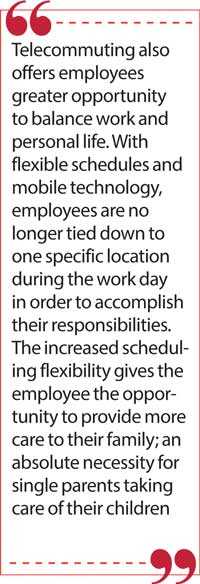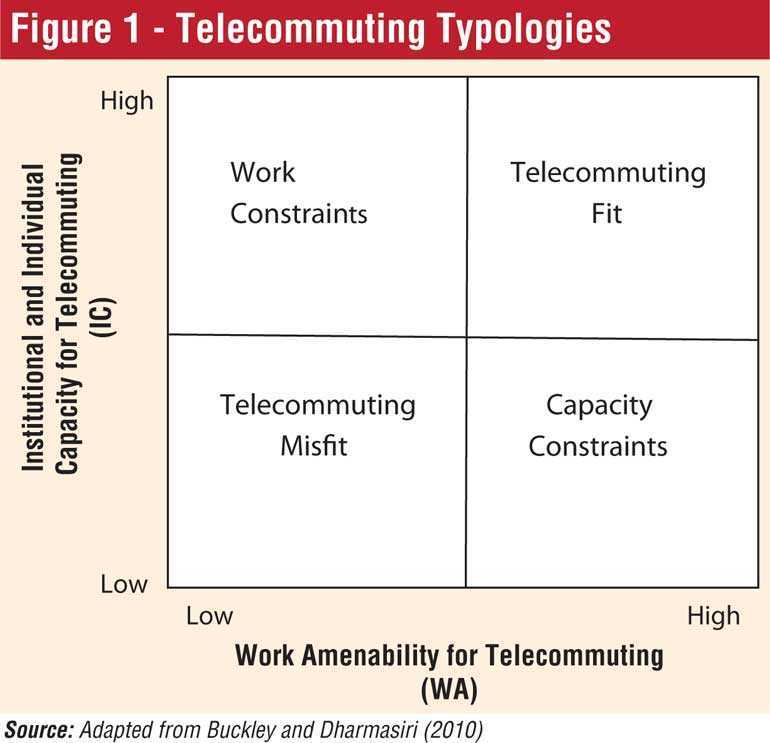Sunday Dec 14, 2025
Sunday Dec 14, 2025
Monday, 30 November 2020 00:00 - - {{hitsCtrl.values.hits}}

Many employees around the world have replaced their commute to work with electronic links to their workplace. Telecommuting to work is trending upward
The second wave of COVID-19 is hitting us much harder than we anticipated. With a high alert level, working from home has again become the dire reality. Some around the globe have been doing it now for so many months. Technically speaking, it is the trend known as telecommuting. The time has come to revisit it and to reflect on it, with effectiveness in mind.
From commuting to telecommuting
It was Sir Arthur C. Clarke who wisely said, “Do not commute but communicate”. When the number of vehicles is on the rise and the roads remain same, the obvious realty is increasing congestion on the  way to work. Commuting has thus become a hassle for many in both private and public sectors alike. A tendency towards a better way to work has become a dire need with the planetary pandemic that we are painfully passing through.
way to work. Commuting has thus become a hassle for many in both private and public sectors alike. A tendency towards a better way to work has become a dire need with the planetary pandemic that we are painfully passing through.
Telecommuting or telework is considered as working outside the conventional workplace and communicating with it by way of telecommunications or computer-based technology. It constitutes an early form of ‘virtual’ work, which has inspired research disciplines ranging from transportation and urban planning to ethics, law, sociology and organisational studies. Amongst several forms of ‘work-at-home’, I would use the term ‘telecommuting’ to refer to work carried out at home during regular office hours by employees of organisations.
Many employees around the world have replaced their commute to work with electronic links to their workplace. Telecommuting to work is trending upward. Although this is an innovative way to complete work, there are significant risks experienced by both the organisation and the employee who is engaged in telecommuting. When a telecommuting experience is unsuccessful there may be a tendency to conclude that the situation was not conducive to telecommuting. This type of conclusion would tell only a part of the story. An important issue pertains to the suitability of an individual for a telecommuting experience. Thus, it is the confluence of a number of individual and organisational issues that will contribute to the suitability of the telecommuting experience for both individual and organisation.
Contributing factors
Certain factors in the last few decades have led toward the reliance on and adoption of telecommunication in the workplace. Many factors contribute to the background, implementation, and advantages of companies executing telecommunication. One such factor contributing to telecommunication is cost reduction. Organisations can save money by reducing the amount of work space and other work environment enhancers in its offices. Campbell (2007) makes the point that less money is spent on workstations, maintenance, utility bills, common office space, and insurance.
Organisations may also implement telecommunication in order to retain ‘geographical freedom’ in the ever-changing work environment. Some companies do not have a static geographical base. Instead they rely solely on telecommunication, and mostly engage in internet-based businesses. Companies can maintain an employee pool worldwide with employees in many time zones, and each person can work at hours convenient for them. Younger generations are more inclined to telecommute due to their familiarity with technology as well as their desire for autonomy in the workplace. Such organisations who encourage telecommuting have more potential to succeed in the event of a natural disaster, terrorist attack, or epidemic.
As we obviously see now, there may be advantages to telecommuting during the traditional height of flu season, not to mention winter blizzards and weather calamities, some experts are advising that businesses prepare for the worst by planning to allow employees to telecommute. Furthermore, in the immediate aftermath of the terrorist attacks of 9/11 in the USA, pre-established telework practices at American Express helped ensure that the business could continue functioning. By decentralising the workforce, companies can still maintain operational readiness under almost any situation.
Individual benefits
In addition to corporate advantages and savings, the individual employee can also benefit from  telecommuting. Organisations who support telecommuting to their employees offer the employees’ fiscal savings on the individual employee’s work-related costs, such as work clothing, transportation, lunches out, child care, and other various costs associated with working outside of the home. Stress related to travel to and from work can be nearly eliminated with the use of telecommuting thus producing a happier, more efficient worker.
telecommuting. Organisations who support telecommuting to their employees offer the employees’ fiscal savings on the individual employee’s work-related costs, such as work clothing, transportation, lunches out, child care, and other various costs associated with working outside of the home. Stress related to travel to and from work can be nearly eliminated with the use of telecommuting thus producing a happier, more efficient worker.
Telecommuting also offers employees greater opportunity to balance work and personal life. With flexible schedules and mobile technology, employees are no longer tied down to one specific location during the work day in order to accomplish their responsibilities. The increased scheduling flexibility gives the employee the opportunity to provide more care to their family; an absolute necessity for single parents taking care of their children.
Employees also save time by eliminating the commute to and from work. These hours can be used for personal pursuits or as additional hours in the work week, thus creating more efficiency and job satisfaction among employees. With increased trust towards employees, companies can expect to gain a return of trust towards company from telecommuting employees.
Telecommuting is also offered as an employee benefit for companies wishing to retain employees who are either unsatisfied with their work environment or who are looking for another job. Hence, the advantages of telecommuting in the workplace, both for the employee and employer, are plenty. Money, moral, efficiency, crisis-reaction, and time are all major factors of implementing telecommuting to the company and individual work-related schedules.
Critical success factors for telecommuting
A clear look at an institution and its individuals will provide a gross yardstick for considering the potential for the implementation of telecommuting. Two most important factors can be identified, in this context. They are the institutional and individual capacity (IC) for telecommuting, and the amenability of the work to telecommuting (WA). Amenability is usually referred to as the flexible nature of work which allows it to be handled by employees in optional ways. Based on the ongoing research work by Professor Michel Buckley of University of Oklahoma and myself, few scenarios can be proposed. Figure 1 shows us four such different scenarios that can occur in this context.
It must be stated that this is mostly an initial evaluation and there could be myriad other factors which influence this decision.
Industry scenarios
Based on the typology described above, several industry scenarios can be considered. Let us look at typical Sri Lankan situations, specially amidst COVID-19 second wave.
Scenario 1: Telecommuting Misfit (IC – low, WA – low)
Nandana is a production supervisor in a manufacturing plant. His work involves physically interacting with the factory operatives. He explored the possibility of working from home, by watching the factory floor through CCTV footage accessible online but was not so realistic. This could be the case with many other industry sectors where physical presence of employees on a daily basis is the norm.
Scenario 2: Work Constraints (IC – high, WA – low)
Nirmana is a creative writer in an advertising firm in Colombo. His company is flexible in allowing him to work from home. However, he has to visit clients and needs to attend regular meetings in others’ offices. Hence, there is a challenge for him to fully resort to telecommuting. A similar case may prevail with many other firms where customers still expect physical interactions.
Scenario 3: Capacity Constraints (IC – low, WA – high)
Nevinda is an entrepreneurial CEO of a trading organisation based in Galle. He has a dozen of marketing executives who used to work in a large office. With the dismal performance of last year, he is under pressure from the board of directors for more stringent cost control. However, he has financial issues in dealing with infrastructure requirements such as computer availability with internet connectivity for his employees. Thus, even though the team is very much willing, the support for telecommuting does not exist here. This is also not very uncommon in many other areas, with the increasing computer literacy rate. Shortcomings in the necessary infrastructure can hinder the cost-effective utilisation of available talent. 
Scenario 4: Telecommuting Fit (IC – high, WA – high)
Nayantha is a systems analyst and enjoys working late night in Kandy. He need not go to office, thanks to the flexible arrangement offered by his firm. With the internet connectivity, he shares his programs with the office and is available for advice. He has access to company servers located in different locations and there is no need to be physically present at meetings in the office. He uses web2 tools to be in touch with his clients and colleagues. This position is very much amenable to telecommuting.
We can find a variety of such opportunities in Sri Lanka. ICT industry can be stated as the forerunner in this approach. With an able set of software developers and having projects that have components that can be handled in a flexible manner, telecommuting becomes possible. Yet, the effectiveness of such a practice relies on several job and family-related factors.
It is worthwhile pondering as to which of the above scenarios is more relevant to one’s workplace, with associated internal and external aspects.
Way forward
Working from home will play an important role in the future world of work. It has its associated challenges and constraints. Maintaining a work-family harmony with increased telecommuting is another vital aspect that needs a separate detailed discussion. As the above typology clearly showed us, it is not the panacea for all corporate illnesses. Careful selection of specific tasks that can be handled through telecommuting, as well as ensuring the availability of necessary infrastructure are critical steps in this direction. This could pave the way for properly being wired rather than becoming weird with regards to working from home.
(The writer can be reached through [email protected], [email protected] or www.ajanthadharmasiri.info.)